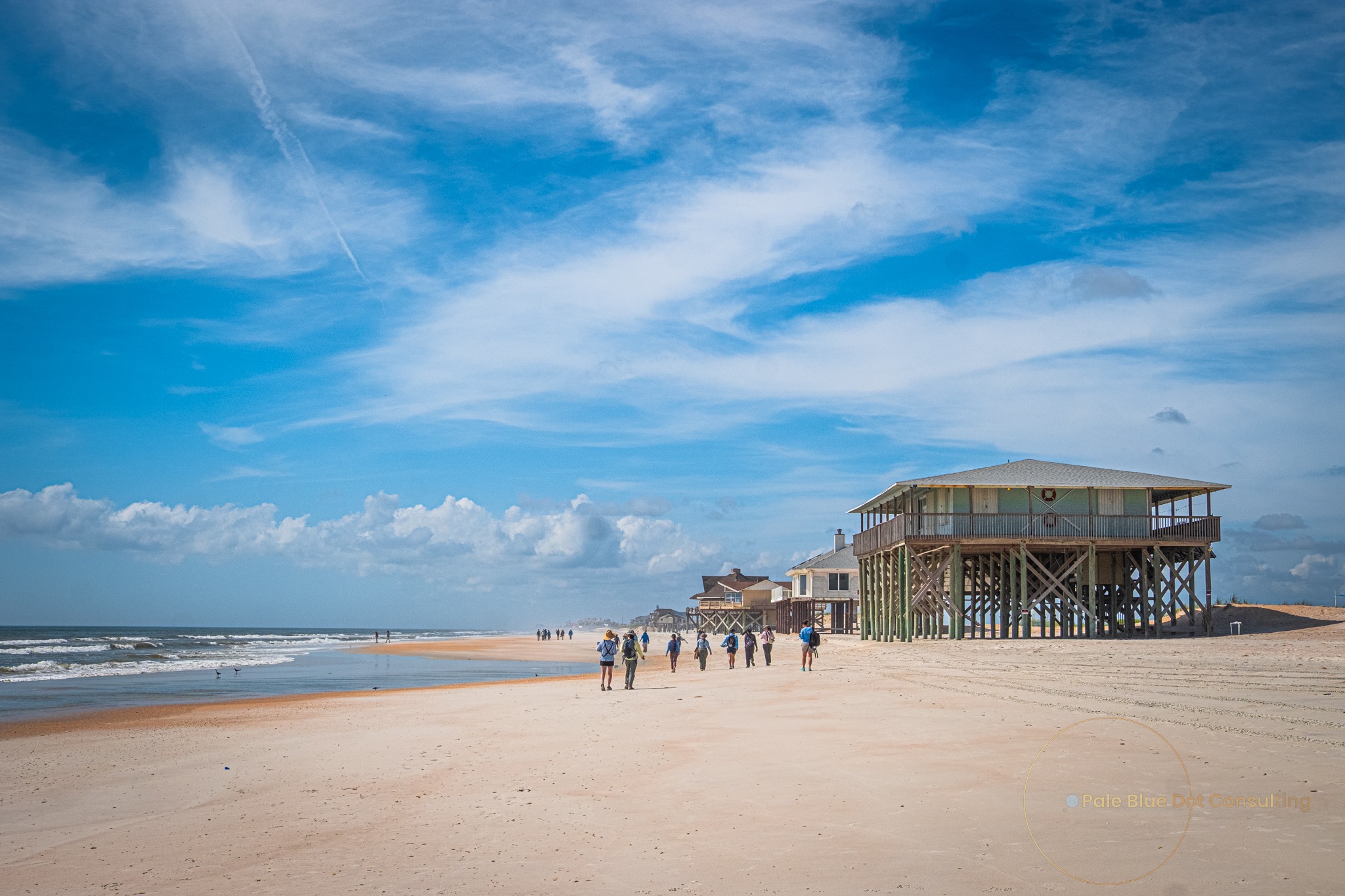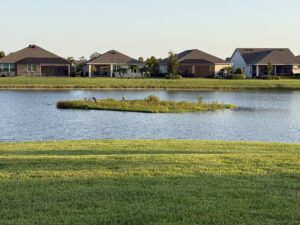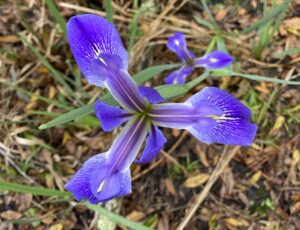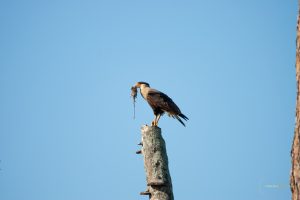Florida’s coastline is a dynamic and beautiful place, not only prized for its scenery and recreation but also for the rare wildlife that calls it home. Among the most vulnerable of these coastal inhabitants are the state’s Imperiled Beach-Nesting Birds (IBNBs), a group of species that depend on sandy beaches, dunes, and tidal flats for their survival. These birds (American Oystercatcher, Black Skimmer, Least Tern, Snowy Plover, and Wilson’s Plover) have evolved to thrive in one of the most exposed and demanding environments in the state. Unfortunately, their habitats are rapidly shrinking due to development, increased recreational use, sea level rise, and predation. Conservation efforts, including regulated monitoring and permitting through the Florida Fish and Wildlife Conservation Commission (FWC), are essential to their persistence. Understanding the ecology and needs of these species is the first step toward their protection.
These birds are protected under various conservation efforts, including the Migratory Bird Treaty Act, Endangered Species Act (ESA), and state-level initiatives. Understanding their life history, identification, breeding behaviors, regulations, and permitting guidelines is important for their protection.
American Oystercatcher (Haematopus palliatus)
The American oystercatcher is listed as a species of high conservation concern by the U.S. Fish and Wildlife Service (USFWS) and state-listed as threatened in some regions, including Florida.
Identification
The American oystercatcher is a striking shorebird with a black head, white underparts, and a dark brown back. Its most distinguishing feature is its long, thick, bright orange-red bill, which it uses to pry open shellfish like oysters, mussels, and clams. It has yellow eyes encircled by a red orbital ring, and its legs are pale pink. When in flight, the oystercatcher displays a bold white wing stripe.
Life History & Habitat
American oystercatchers inhabit coastal beaches, sandbars, and tidal flats, where they forage for bivalve mollusks. Unlike some other shorebirds that migrate long distances, many populations remain in the same general region year-round, especially in the southeastern U.S. Unlike least terns and black skimmers, oystercatchers will nest in grassy vegetation and even oyster barrens above tidelines.
Breeding & Nesting
The breeding season runs from March to August, with peak nesting activity occurring between April and June. Oystercatchers are monogamous and often return to the same nesting sites annually. They lay one to three eggs in shallow scrapes on sandy or shelly beaches, where the eggs blend in with their surroundings. Both parents take turns incubating the eggs, which hatch in about 25–27 days. Chicks are precocial, meaning they can move and feed themselves shortly after hatching, though they rely on their parents for food.
Survey Windows
Surveys for American oystercatchers typically occur from March to August, focusing on nesting sites and chick survival rates. Population monitoring often extends into fall to track post-breeding movements.
Black Skimmer (Rynchops niger)
Black skimmers are state-listed as threatened in multiple states, including Florida.
Identification
Black skimmers are unique among shorebirds due to their striking black-and-white plumage and an unusual bill structure. They have a black upper body, white underparts, and a bright red-and-black bill where the lower mandible is significantly longer than the upper. This adaptation allows them to skim the water’s surface for fish. Their eyes are small and dark, helping reduce glare from the water.
Life History & Habitat
Black skimmers are highly social and often found in large colonies along sandy beaches, barrier islands, and coastal lagoons. They feed primarily on small fish by flying low over the water and using their specialized bill to catch prey.
Breeding & Nesting
Breeding season runs from May to September, with peak nesting from June to July. Black skimmers nest in dense colonies on open sand, typically alongside least terns. They lay three to five eggs in shallow depressions in the sand, and both parents take turns incubating for 21–23 days. The chicks hatch covered in down and remain in the nest for several weeks, being fed regurgitated fish by their parents.
Survey Windows
Surveys take place from May to September, with a focus on colony size, nest success, and chick survival. Conservationists often monitor human activity near colonies to minimize disturbances.

Least Tern (Sternula antillarum)
The interior population of the least tern is federally endangered, while coastal populations are state-listed as threatened or species of concern in several states.
Identification
The least tern is North America’s smallest tern, measuring about 9 inches in length. It has a black cap and eye stripe, white forehead, gray wings, and a yellow bill with a black tip. Its tail is forked, and its flight is characterized by quick, fluttery wingbeats.
Life History & Habitat
Least terns primarily inhabit sandy beaches, barrier islands, and dredge spoil islands. They feed by diving into shallow waters for small fish. Unlike many other terns, least terns can adapt to nesting on gravel rooftops in urban areas when natural habitats are scarce.
Breeding & Nesting
The breeding season spans April to August, with peak nesting from May to July. Least terns nest in colonies on sandy, open areas where they scrape shallow nests in the sand. Clutches typically contain one to three eggs, which hatch in about 21 days. Chicks are highly mobile soon after hatching but rely on parental care for feeding.
Survey Windows
Surveys for least terns are conducted from April to August, focusing on colony numbers, nest success, and threats like predation and habitat disturbance.
Snowy Plover (Charadrius nivosus)
The Pacific Coast population of the western snowy plover is federally listed as threatened, while other populations are state-listed as threatened or endangered in states like Florida and Texas.
Identification
The snowy plover is a small, pale shorebird with a round body, short black bill, and slender black legs. It has light sandy-gray plumage on its back and a white belly, which provides excellent camouflage against sandy environments. During the breeding season, adults have black markings on their foreheads, behind their eyes, and along the sides of their necks.
Life History & Habitat
Snowy plovers prefer wide, open beaches, salt flats, and dune systems, where they forage for insects, crustaceans, and other small invertebrates. They are generally non-migratory in warmer regions but may disperse to wintering areas along the Gulf of Mexico and Central America.
Breeding & Nesting
Breeding occurs from March to September, with peak nesting from April to July. Snowy plovers create shallow nest scrapes on open sand or shell-covered beaches. They lay two to three eggs, which are incubated for about 25–30 days. Chicks leave the nest within hours of hatching and rely on their parents for protection but feed themselves.
Survey Windows
Monitoring takes place from March to September, with surveys focusing on nest site identification and chick survival. Efforts often intensify during peak breeding months to minimize human disturbance and predation risks.
Wilson’s Plover (Charadrius wilsonia)
The Wilson’s plover is not currently listed as a state-designated Threatened in Florida, but its status is being discussed due to habitat loss, human disturbance, predation and similarity of habitat to other imberiled beach-nesting birds. While it is not federally listed, it receives special protection at the state level to safeguard its declining nesting populations across Florida’s coasts.
Identification
Wilson’s plover is a medium-sized plover with a stocky build, a thick, dark bill, and long pinkish legs. Its plumage is sandy brown above and white below, with a single bold dark breast band. During the breeding season, adults show more contrast in their markings, with males typically exhibiting a darker face and breast band. Its heavy bill, which is larger than other small plovers, helps distinguish it in the field.
Life History & Habitat
This species prefers quiet, low-energy coastal habitats such as sandy beaches, shell rakes, barrier island flats, and tidal lagoons. It forages primarily on mudflats and salt flats for small crustaceans, insects, and marine worms, often focusing on fiddler crabs and other invertebrates. Wilson’s plovers are mostly resident along Florida’s coasts, although some individuals may disperse short distances seasonally or in response to local disturbance.
Breeding & Nesting
Breeding begins in Florida as early as March and continues through July or August. Wilson’s plovers are solitary nesters and strongly territorial during the breeding season. They create shallow scrapes in the sand or shell, usually in sparsely vegetated areas that offer both visibility and concealment. Each clutch typically consists of two or three speckled eggs. Chicks hatch precocial and are mobile within hours, but they rely on parental guidance and protection until fledging.
Survey Windows
Monitoring for Wilson’s plover nesting activity begins in early March and extends through the end of the summer breeding season. Surveys focus on locating nests, delineating territories, and documenting chick survival and fledging success. Early detection of nesting pairs is essential for implementing protective buffers and ensuring that nearby construction or recreation activities comply with state permitting requirements.
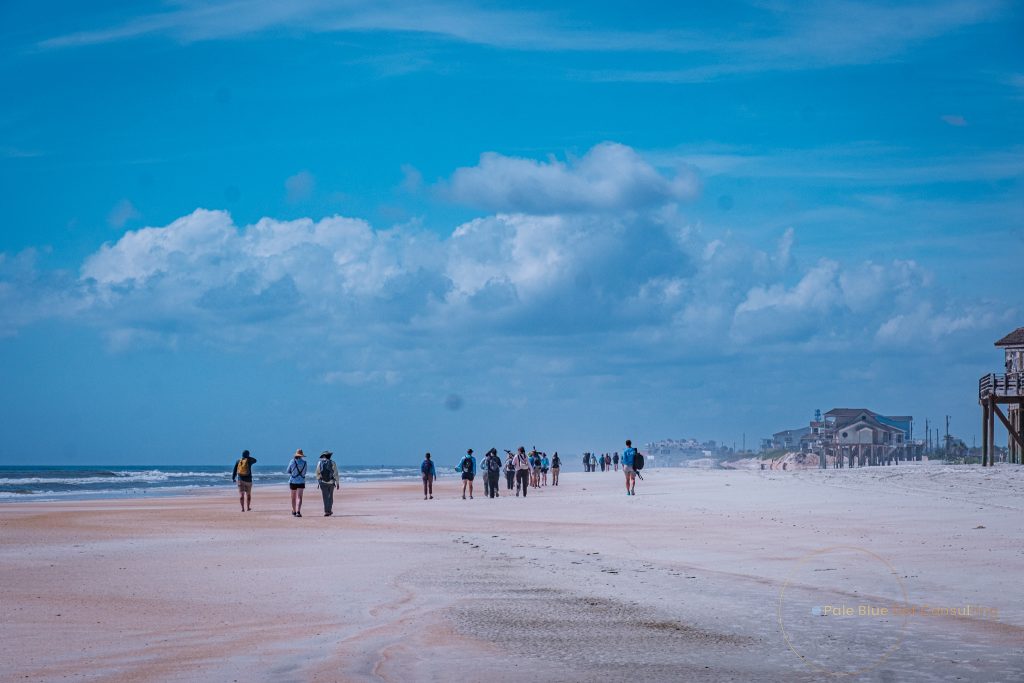
Conservation Challenges & Protection Efforts
Shorebirds face significant threats, including habitat loss, human disturbance, predation, and climate change. Coastal development and beach erosion have reduced available nesting sites, while increased recreational activity on beaches can destroy nests or scare off parents, leaving eggs and chicks vulnerable. Unleashed dogs, off-road vehicles, and beachgoers can unintentionally disrupt breeding birds. Additionally, natural predators such as raccoons, gulls, and crows pose a serious risk, along with the increase of less-natural predators such as feral cats and dogs, and human-altered landscapes often increasing predation rates. Climate change further threatens shorebird populations, as rising sea levels and extreme weather events can flood nesting sites and disrupt food availability.
To mitigate these threats, conservationists implement beach closures and buffer zones to protect nesting areas during the breeding season (you may have seen roped off areas of beaches to protect active nesting colonies). Educational programs and public outreach campaigns help raise awareness about shorebird conservation, encouraging people to respect designated nesting areas and leash their pets. Predator management programs, such as fencing off nesting sites or controlling invasive species, have also proven effective in improving chick survival rates. Additionally, ongoing monitoring and research through surveys and banding programs provide critical data to track population trends and assess conservation strategies.
If you encounter protected shorebirds while visiting the beach, remember to observe from a distance, avoid disturbing nests, and follow any posted guidelines. Your actions can make a difference in preserving these incredible birds and their habitats.
Permitting Guidelines
Because these shorebirds are protected under federal and state laws, any activity that could disturb nesting birds — such as coastal construction, scientific research, or beach nourishment projects — may require a permit from the U.S. Fish and Wildlife Service (USFWS), Florida Fish and Wildlife Conservation Commission (FWC), or other state-specific wildlife agencies. Permits are typically required for:
• Scientific research, including banding, surveying, or handling birds.
• Habitat modifications, such as construction, dredging, beach renourishment, or vegetation management.
• Human activity restrictions, including concerts, weddings, or other events.
Permit applicants must demonstrate that their activities will minimize impact on shorebird populations and may be required to implement mitigation measures, such as habitat restoration or monitoring programs.
Pale Blue Dot staff recently attended a Florida Fish and Wildlife Conservation Commission (FWC) training crash course on identification, surveying and monitoring protocols, and permitting guidelines for Florida’s IBNBs. With additional training by volunteering with local Audubon chapters to steward and monitor beach-nesting birds in Pinellas County, PBD staff are now FWC-permitted monitors that can help with project planning, conduct IBNB surveys, designate and protect active beach nesting habitat, educate construction crews and the public on beach-nesting species and their protected habitat, and help project managers attain FWC permits related to imperiled beach-nesting birds.
